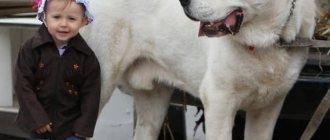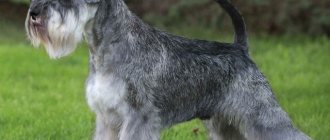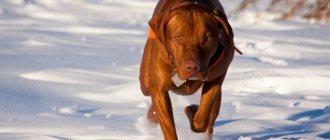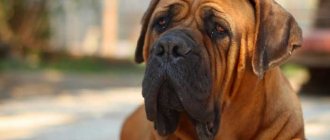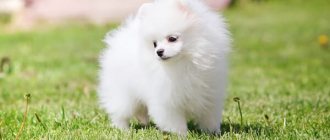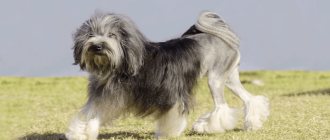Ibizan Greyhound
- Region of origin: Balearic Islands
- Approximate date: 3000 BC. e.
With the grace of a deer and a long, lean build, Ibizans may share common roots with the Pharaoh Hound. In appearance, they resemble dogs depicted on tombs in Ancient Egypt dating back to the third millennium BC.
Bred to hunt small game, especially rabbits, the Ibizan Hound was kept purebred to preserve its incredibly keen sense of smell and hearing. Considered a rare breed by today's standards, Ibizans were officially recognized by the dog breed almost half a century ago.
Chow chow
Thanks to their thick fluffy fur and funny elongated tongue, these pets resemble teddy bears. But in reality they are much stronger and stronger than they seem at first glance.
The ancestors of modern Chow Chows were once used to guard ancient temples and for hunting. They can be cruel when it comes to protecting their owners from any external threats.
Shiba Inu
- Region of origin: Japan
- Approximate date: 300 BC. e.
DNA analysis shows that the Shiba Inu is one of the oldest Asian dog breeds, dating back to the 3rd century BC. This small, agile dog copes well with overcoming the obstacles of the mountain landscape. It was originally bred to hunt game. The Shiba Inu is similar to and is often mistaken for other Japanese hunting dogs such as the Hokkaido and Akita Inu, although it has a different disposition and is more compact in size.
This is one of the few ancient dog breeds that still exist in the world. The breed almost went extinct during World War II and is still rare today. The Shiba Inu was brought to the Russian Federation only at the end of the 20th century.
Pekingese
Now everyone knows the Pekingese, but in ancient times this breed of dog was available only to aristocrats. In Ancient China, it was believed that these animals combined the characters of a proud monkey and a brave lion. Therefore, attempts to steal a Pekingese 2 thousand years ago were punishable by death.
The presence of hunting skills, endurance and courageous character do not fit in with the ancient breed, given the miniature physique of its individuals. This is a rare case when short stature is an advantage of an animal.
Lhasa apso
- Region of origin: Tibet
- Approximate date: 800 BC. e.
The Lhasa Apso is originally from Tibet. The breed was bred by Buddhist monks as a guardian who warned the monks of any intruders. The capital of Tibet is “Lhasa” and “apso” is a Tibetan word meaning “bearded”. Hence, "Lhasa Apso" translates to "bearded dog from Tibet." However, another version is also widespread. Many believe that the word "apso" is a reference to the Tibetan word "rapso", meaning "goat". The Lhasa Aspo probably guarded timid Tibetan domestic goats. The Lhasa Apso first appeared in Europe at the beginning of the 20th century.
Alaskan Malamute
The Alaskan Malamute is a Scandinavian sled dog named after the Alaskan tribe that raised the dogs. The breed is descended from the Arctic wolf, and was originally used to pull sleds.
Like Samoyeds, these dogs also participated in polar expeditions, including Admiral Byrd's exploration of the South Pole. The Alaskan Malamute is related to three other Arctic breeds, including Siberian Huskies, Samoyeds and American Eskimo dogs.
Peruvian hairless dog
- Region of origin: Peru
- Approximate date: 300 BC. e.
The breed is first depicted on ancient pottery dating back to 750 AD. But the Peruvian Hairless Dog appeared long before that. It was maintained by the Inca tribes and their descendants, the Quechua. The breed comes in two varieties: hairless or sparsely haired. Wool comes in different colors.
Loyal, vigilant and energetic, the Peruvian Inca Orchid requires a lot of daily activity to stay healthy and happy. Socialization from an early age is also important. Due to their hunting instincts, this breed may not get along well with small animals.
Tibetan Terrier: Talisman of Good Luck
The holy Tibetan dog lived for a long time under the supervision of monks who took care of the pets. The animal was highly valued for its loyalty and good companionship qualities, treating all family members well. The terrier was considered a talisman of good luck, so no owner dared to sell it, and puppies were presented as gifts. There was an opinion that an owner who mistreated his friend was sure to invite trouble.
Saluki
- Region of origin: Middle East
- Approximate date: 3500 BC. uh
Evidence of the Saluki can be traced back to the Early Kingdom of ancient Egypt, where they were used by nomads to catch foxes, ibex, hares and gazelles in the desert. This graceful and fast Persian hound is famous for its endurance and strength, which allowed it to hunt in sandy or rocky areas.
Shaped like a typical greyhound, they come in two varieties: smooth and feathered. Although they are an independent breed that requires patient training, they are gentle and affectionate with their owners. Salukis are sensitive, calm, gentle and devoted to their family members. Due to their strong hunting instincts, they often chase small animals and like to run quickly across open spaces.
Alabai: description, breeding
The breed was formed over 4000 years, and the blood of shepherd, fighting, and nomadic dogs flows in its veins. During the formation of the breed, the dogs went through cruel natural selection: harsh climatic living conditions, protection of homes and livestock, hard physical labor and the fight against predators - all this strengthened their character and gave them the appearance and endurance that we know now.
The standard for this ancient dog breed was adopted only in 1993; mitigating changes were made in 2000 and 2010. Today the following standard applies:
- The dimensions of a male at the withers are at least 70 cm, for females - at least 65 cm.
- Weight - from 40 to 80 kg.
- The physique is powerful, the paws are strong, widely spaced, the chest is wide, the belly is tucked, and the rear is high.
- Working qualities - protection and security.
Today, many people get an Alabai as a companion, and this dog is perfect for this role. Easy to train, friendly to children and other animals.
Alabais are bred in many cities of Russia, so it is not difficult to buy a high-breed puppy.
Greyhound
- Region of origin: UK
- Approximate date: 600 BC. uh
This ancient breed, similar to the greyhounds depicted in art from Greek, Egyptian and Roman times, also became popular among English nobility and commoners. Known for their ability to run quickly and catch game with agility, greyhounds became sought after for hunting rabbits and foxes in the 1800s and then began competing as hound dogs in America in the 1900s.
English greyhounds are sensitive, independent and calm. They get along well with other pets and dogs they grew up with.
Basenji
The Basenji
is believed to be one of the oldest domesticated dogs. Its reputation as a dog that does not bark may be due to the fact that ancient people preferred a quiet dog as a hunter. Basenjis bark, but usually only once and then remain silent.
Another interesting aspect of this breed is that it can only be partially domesticated. The Basenji's metabolism is different from that of any other domesticated dog, with females having only one cycle per year compared to other domesticated dogs which have two cycles per year.
Basenjis were used by African tribes to play, carry objects, and warn of possible dangers. The American Kennel Club recognized this breed in 1943.
Anatolian Shepherd
Anatolian Shepherd or Kangal. Back in Babylonian times, this dog lived in Asia Minor. The common Turkish name for the breed is Kangal, or Turkish Guard Shepherd. In ancient times it was used to hunt lions, and later as a guard against predators for livestock. Thanks to her physique, she is quite capable of catching up and neutralizing a wolf. Now used as a security guard, watchman or just a pet, she can be raised as an excellent nanny.
Siberian Husky
Siberian Husky - the breed originates from northern wolves. The ancient Chukchi tribes were the first to appreciate the qualities of this breed; they were used to transport goods over long distances. There is evidence that huskies have existed for more than 4,000 years ; in the 19th century, the breed became known throughout the world. Now the breed is very popular and widespread, thanks to its excellent qualities it has become a symbol of honor, valor and willpower.
Deerhound
The Deerhound is one of the oldest hunting breeds, originally from Scotland. The descendants of the hunting Picts became known in the 16th century , they were very valuable because of their speed, courage and endurance, and were used in deer hunting. In the 18th century, the breed was on the verge of extinction, but it was saved and now it is a wonderful pet in many families around the world.
Scientific substantiation of the antiquity of the breed
None of the existing breeds can be called ancient in the traditional sense, since over the course of a long history animals have crossed and there are no pure representatives whose appearance or behavior has not changed over several thousand years. But there is a group of animals whose genetic code (DNA) has minimal differences from their ancestors (wolves or jackals). This coincidence suggests that the breed was formed in ancient times and has not undergone significant changes.
In 2004, American scientists conducted a study in which 85 breeds of the aboriginal type took part (naturally formed in certain environmental conditions with minimal or complete absence of breeding work under human control). The study of genetic markers made it possible to identify 14 breeds that are most similar to their ancestors - they are recognized as the oldest in the world. The results were published in the journal Science under the title Genetic structure of the purebred domestic dog.
This study cannot be considered absolutely reliable, since only a portion of dog breeds were studied. However, the information received is unique; a partial sample made it possible to establish ancient breeds, but this does not mean that there are exactly 14 of them and not more.
